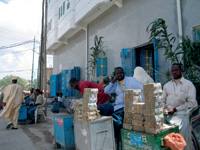Somalia, the hardest famine of the last half century
- In four rainy seasons, drought has become widespread in the country and has affected half of the population, with 213,000 people in serious hunger. Malnutrition has spread and the UN estimates that it affects 1.5 million children.

The situation in Somalia is extreme: they are suffering the hardest famine of the last 50 years, according to UN data. The stimulus has been the widespread drought in the country, as drought has prevailed over the last four rainy periods. This has inevitably led to widespread uncertainty in the country, as drought affects half the population, 7.8 million people, of whom 213,000 are at serious risk of famine.
The humanitarian aid organizations present in the area have been warning of the seriousness of the situation for months. For example, the UN has announced that in August 44,000 children were treated in health institutions affected by malnutrition, although the children who suffer from it are much more, the organization expects about 1.5 million children. This malnutrition makes children more vulnerable to hunting for diarrhoea and measles, and many times more likely to die than a child with adequate nutrition.
The situation is not new in the country of the Horn of Africa, where arid river flows and rainless times are frequent. The territory is arid and that is why high rains are so important. They usually have two a year: between October and December, and between March and June. All alarms have therefore skyrocketed by the drought of the past four years; even weather forecasting has announced the same trend by the time it comes.
From drought to drought, getting poorer
To understand the gravity of the situation, a decade ago, in 2011, in the same situation as the current one, after the generalization of the drought in three rainy seasons. The people who suffered the direct damage from drought at that time were half of the current ones, but 260,000 people died.
Somalia struggled to turn the 2011 situation around, and the drought has come back. The most affected have been, above all, the inhabitants of the rural areas, as the lack of water has led to the loss of crops in orchards, the reduction of jobs and the slaughter of livestock. This has been accompanied by a decrease in inflation and the purchasing power of families, with the consequent risk to feeding poorer families.
The situation in the country is fragile. Seven out of ten Somalians live on less than 2 euros a day. In addition, climate change is being experienced first-person and affects them fully in their lives, as has been seen in 2011 and today. Although there are many other types of problems in the country, school enrolment rates are around 32 per cent, the main current risk is drought, which the UN estimates to be $2 billion.
Eraso jihadistek ez dute etenik Somalian: historiako atentaturik odoltsuenaren ostean, –orain dela bi aste 300 hildako baino gehiago izan ziren– beste eraso bat izan da Muqdishonen, Somaliako hiriburuan: bi bonba-autok eztanda egin zuten hiriaren erdigunean... [+]
Larunbat arratsaldean gertatu zen atentatua Mogadiscio hiriburuan. Lehergaiz beteriko bi kamioi leherrarazi zituzten hiriaren erdigunean. Al Shabab talde islamistari egotzi diote erasoa, baina oraindik ez du bere gain hartu.










